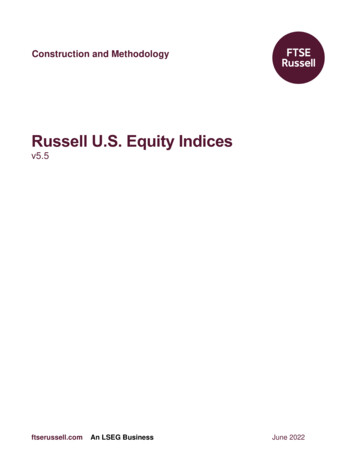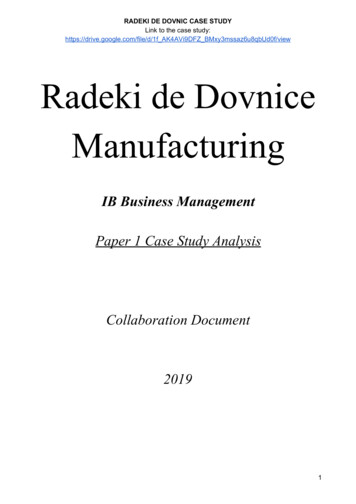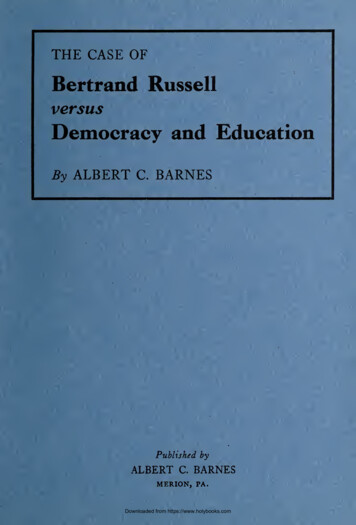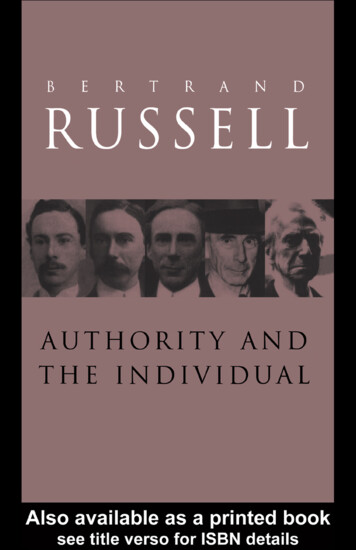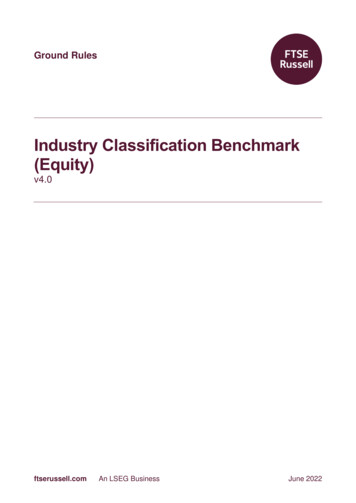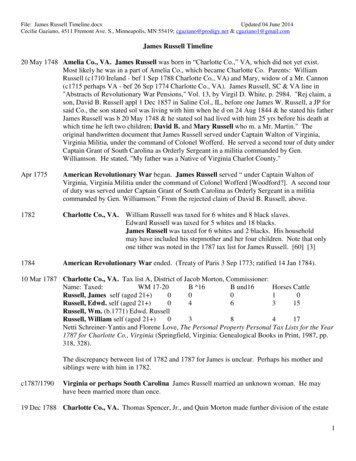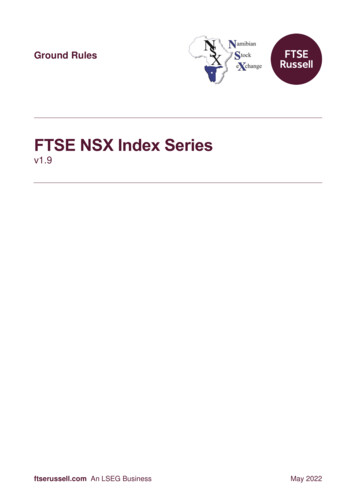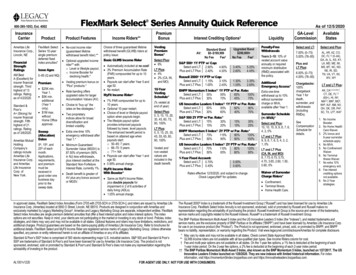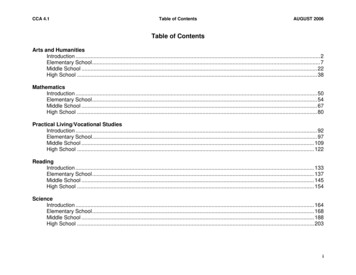
Transcription
CCA 4.1Table of ContentsAUGUST 2006Table of ContentsArts and HumanitiesIntroduction . 2Elementary School . 7Middle School . 22High School . 38MathematicsIntroduction . 50Elementary School . 54Middle School . 67High School . 80Practical Living/Vocational StudiesIntroduction . 92Elementary School . 97Middle School . 109High School . 122ReadingIntroduction . 133Elementary School . 137Middle School . 145High School . 154ScienceIntroduction . 164Elementary School . 168Middle School . 188High School . 203i
CCA 4.1Table of ContentsAUGUST 2006Social StudiesIntroduction . 217Elementary School . 222Middle School . 235High School . 251WritingIntroduction . 265Elementary School . 269Middle School . 288High School . 308ii
CCA 4.1Arts and Humanities IntroductionAUGUST 2006Core Content for Arts andHumanities AssessmentVersion 4.1August 2006Kentucky Department of Education1
CCA 4.1Arts and Humanities IntroductionAUGUST 2006IntroductionCore Content for Arts and Humanities AssessmentWhat is the Core Content for Arts and Humanities Assessment?The Core Content for Assessment 4.1 (CCA 4.1) is a subset of the content standards in Kentucky’s Program of Studiesfor Grades Primary – 12. It represents the content standards that will be assessed beginning with the spring 2007 stateassessment. The Core Content for Arts and Humanities Assessment Version 4.1 represents the arts and humanitiescontent from Kentucky’s Academic Expectations and Program of Studies that is essential for all students to know and thecontent that is eligible for inclusion on the state assessment. Version 4.1 Core Content for Arts and HumanitiesAssessment and the Academic Expectations provide the parameters for test developers as they design the stateassessment items. These content standards provide focus for the development of the Kentucky Core Content Test(KCCT) beginning in 2007.The Core Content for Arts and Humanities Assessment is not intended to represent the comprehensive local curriculumfor arts and humanities assessment and instruction. It is also not the comprehensive Program of Studies for Arts andHumanities, which specifies the minimum content for the required credits for high school graduation, and the primary,intermediate and middle-level programs leading to these requirements.Kentucky Academic Expectations for Arts and HumanitiesThe Kentucky Academic Expectations define what students should know and be able to do upon graduation from highschool. These large goals were used as a basis for developing the Program of Studies and the Core Content forAssessment.Goal 1: Students are able to use basic communication and mathematics skills for purposes and situations they willencounter throughout their lives.1.121.13Students speak using appropriate forms, conventions,and styles to communicate ideas and information todifferent audiences for different purposes. (Drama)Students make sense of ideas and communicate ideaswith the visual arts.1.14Students make sense of ideas and communicate ideaswith music.1.15Students make sense of and communicate ideas withmovement. (Dance)2
CCA 4.1Arts and Humanities IntroductionAUGUST 2006Goal 2: Students shall develop their abilities to apply core concepts and principles from mathematics, the sciences, thearts, the humanities, social studies, practical living studies, and vocational studies to what they will encounter throughouttheir lives.2.22Students create works of art and make presentations toconvey a point of view.2.23Students analyze their own and others' artistic productsand performances using accepted standards.2.24Students have knowledge of major works of art, music,and literature and appreciate creativity and thecontributions of the arts and humanities.2.25In the products they make and the performances theypresent, students show that they understand how time,place, and society influence the arts and humanities suchas languages, literature, and history.2.26Through the arts and humanities, students recognize thatalthough people are different, they share some commonexperiences and attitudes.How is the Core Content for Arts and Humanities Assessment organized?Version 4.1 Core Content for Arts and Humanities Assessment is organized by grade level (end of primary, 4th, 5th, 6th, 7th,8th, 9th, 10th, 11th and 12th) in order to ensure continuity and conceptual development. This is different from Version 3.0,which was organized in grade spans. This version of the Core Content for Arts and Humanities Assessment includes ‘offyear’ content standards as well as content for the assessed grades (five, eight and eleven).SUBDOMAINS with related ORGANIZERSSubdomainOrganizersSubdomainStructures in theArtsMusicDanceDrama/TheatreVisual ArtsHumanity in theArtsPurposes forCreating the ArtsMusicDanceDrama/TheatreVisual ArtsProcesses in the MusicArtsDanceDrama/TheatreVisual ArtsOrganizersMusicDanceDrama/TheatreVisual Arts3
CCA 4.1Arts and Humanities IntroductionSubdomainAUGUST 2006OrganizersInterrelationshipsAmong the ArtsMusicDance(high school level only) Drama/TheatreVisual ArtsCreating and performing in the arts is included under the Processes in the Arts subdomain. All other subdomains addressthe process of responding to the arts. Since Processes in the Arts involves creating and performing in the arts, contentstatements on this part of the document will not be assessed as a part of the state KCCT assessment. However, creatingand performing the arts is an absolute necessity for students to be able to understand and have context to respond to thearts on a proficient level. This part of the Arts and Humanities Core Content for Assessment should be part of thecomprehensive arts curriculum.The Core Content for Arts and Humanities Assessment is organized into five subdomains, which are further defined withinthe Core Content for Assessment. The five subdomains for arts and humanities are: Structures in the ArtsHumanity in the ArtsPurposes for Creating the ArtsProcesses in the ArtsInterrelationships Among the Arts (high school level only)The Core Content for Arts and Humanities Assessment includes state assessed standards and supporting contentstandards. Supporting content standards are not used for state assessment. Supporting content, however, is critical to thestudent’s deep understanding of the overall content and is to be used by schools to build a foundation of knowledge,skills, and processes that will enable students to be successful on the Kentucky Core Content Test. In order for studentsto reach proficiency and beyond on the KCCT, students need to master the supporting content as well as the stateassessed content. Supporting content standards are proposed for local instruction and assessment and appear in italics inthe Core Content document. The content standards for the state assessment are in bold print.4
CCA 4.1Arts and Humanities IntroductionAUGUST 2006Some Core Content standards contain additional information in parentheses. A list preceded by an e.g., means theexamples included are meant to be just that, examples and may be on the state assessment. Other examples notincluded may also be on the state assessment. However, if the list is not preceded by an e.g., the list is to be consideredexhaustive and the items inside the parentheses are the only ones that will be assessed.A new aspect of the refined Core Content for Arts and Humanities Assessment Version 4.1 is Depth of Knowledge (DOK).Version 4.1 reflects the depth of knowledge and cognitive complexity for the content standard that is appropriate for eachgrade level for the state assessment.Each of the state-assessed standards in the Core Content has a ceiling DOK level indicated. This means that an item onthe state assessment cannot be written higher than the ceiling for that standard. An item could be written at a lower level.When writing an assessment item, developers need to make sure that the assessment item is as cognitively demandingas the expectation of the content standard in order to assure alignment of the test items and the standards. The DOKindicated for the state assessment is not meant to limit the cognitive complexity for instruction in the classroom.Classroom instruction needs to extend beyond the depth of knowledge and cognitive complexity that can be assessed onthe state assessment so that students have the opportunities and experiences they need in order to reach proficiency andbeyond. The levels for DOK are based on the research of Norman Webb from the University of Wisconsin-Madison. Moreinformation about DOK levels can be found at the Kentucky Department of Education website.What do the codes for the Core Content for Arts and Humanities Assessment mean?Each content standard is preceded by a code. The code begins with AH for arts and humanities and is then followed by agrade level designation and then a 3-digit number that indicates subdomain, organizer and sequential standard,respectively. The codes used are listed below.Grade Level CodesEP end of primary04 fourth grade05 fifth grade06 sixth grade07 seventh grade08 eighth gradeHS high schoolSubdomain1 Structures in the Arts2 Humanity in the Arts3 Purposes for Creating the Arts4 Processes in the Arts5 Interrelationships Among the ArtsOrganizer1 Music2 Dance3 Drama/Theatre4 Visual Arts5
CCA 4.1Arts and Humanities IntroductionAUGUST 2006A typical code may look like AH-05-1.1.1. This means fifth grade arts and humanities in the subdomain of (1) Structures inthe Arts, in the organizer (1) music and (1) is the first standard listed for that organizer at that grade level.AH-05-1.1.1AH Arts and Humanities (domain)05 fifth Grade1 Structures in the Arts (subdomain)1 Music (organizer)1 (first standard)6
CCA 4.1Elementary Arts and HumanitiesAUGUST 2006Structures in the ArtsUnderstanding of the various structural components of the arts is critical to the development of other larger concepts in the arts. Structures thatartists use include elements and principles of each art form, tools, media and subject matter that impact artistic products and specific styles andgenre that provide a context for creating works. It is the artist's choice of these in the creative process that results in a distinctively expressivework. Students make choices about how to use structural organizers to create meaningful works of their own. The more students understand, thegreater their ability to produce, interpret or critique artworks from other artists, cultures and historical periods.4th Grade5th GradeAH-EP-1.1.1Students will begin to recognize andidentify elements of music using musicalterminology.AH-04-1.1.1Students will identify or describe elements ofmusic in a variety of music.DOK 2AH-05-1.1.1Students will analyze or explain the use ofelements of music in a variety of music.DOK 3Elements of music:Rhythm - bar lines, measures, wholenotes, half notes, quarter notes(aurally and visually)Tempo - steady beat, slower, faster(aurally)Melody – notes, lines and spaces ontreble clef staff (visually)Harmony - rounds and simple 2-partsongs (aurally), songs are major orminor (aurally)Form - call and response form, ABform and ABA form (aurally)Timbre (tone color) - recognizedifferent qualities of musical sounds,instruments by family-brass,woodwind, string, percussion (aurallyand visually) and human voices(aurally)Dynamics - soft, loud (aurally)Elements of music:Rhythm - time signature (2/4, 3/4, 4/4), barlines, rhythmic durations (whole, half,quarter, eighth notes and rests), measureTempo - steady beat, slower or fasterMelody - shape, direction (pitches moveup, down, by step, by skip, stay the same),treble clef sign, pitch notation (notes frommiddle C to F at top of treble clef staff),high vs. low notes (pitches)Harmony - parts (notes performed togetherto create harmony), major/minor (aurally);unison (non-harmony)Form - call and response, two-part (AB),three-part (ABA), round, verse/chorus,repeat signsTimbre (tone color) - recognize differentqualities of musical sounds, orchestralinstruments by family - brass, woodwind,string, percussion, how instrumentsounds are produced, human voices (highvoices, low voices)Dynamics - soft (piano - p), medium softElements of music:Rhythm - time signature (2/4, 3/4, 4/4), barlines, rhythmic durations (whole, half,quarter, eighth notes and rests), measureTempo - steady beat, slow, fastMelody - shape, direction (pitches move up,down, by step, by skip, stay the same),treble clef sign, pitch notation (notes frommiddle C to F at top of treble clef staff), highnotes vs. low notes (pitches)Harmony - parts (notes performed togetherto create harmony), major/minor (aurally);unison (non-harmony)Form - call and response, two-part (AB),three-part (ABA), round, verse/chorus,repeat signsTimbre (tone color) - recognize differentqualities of musical sounds, orchestralinstruments by family - brass, woodwind,string, percussion, how instrument soundsare produced, human voices (high voices,low voices)Dynamics - soft (piano - p), medium softEnd of PrimaryMusicBold – State Assessment Content StandardItalics – Supporting Content Standard7
CCA 4.1Elementary Arts and Humanities(mezzo piano - mp), medium loud (mezzoforte - mf), loud (forte - f)AH-EP-1.1.2Students will identify various styles ofmusic (spirituals, game songs, folk songs,work songs, lullabies, patriotic,bluegrass).AUGUST 2006(mezzo piano - mp), medium loud (mezzoforte - mf), loud (forte - f)AH-04-1.1.2Students will identify and describe various stylesof music (spirituals, game songs, folk songs,work songs, lullabies, patriotic, bluegrass).AH-05-1.1.2Students will identify and describe various stylesof music (spirituals, game songs, folk songs,work songs, lullabies, patriotic, bluegrass).AH-EP-1.2.1Students will observe dance/movementand describe elements and movementsusing dance terminology.AH-04-1.2.1Students will identify or describe elements ofdance in a variety of dances.DOK 2AH-05-1.2.1Students will analyze or explain the use ofelements of dance in a variety of dances.DOK 3Elements of dance:Space – direction of dance movements(forward, backward, right, left, up, down),pathway (straight, curved, zigzag), levels(high, middle, low), shape (individual andgroup shapes)Time (tempo) – dance movements thatfollow a steady beat or move faster orslowerForce – dance movements that use moreor less energy (e.g., gentle movementsversus strong movements)Elements of dance:Space – direction of dance movements(forward, backward, right, left, up, down),pathway (straight, curved, zigzag), levels(high, middle, low), shape (individual andgroup shapes)Time (tempo) – dance movements thatfollow a steady beat or move faster orslowerForce – dance movements that use moreor less energy (e.g., energy sharp/smooth, weight - heavy/light, flowfree/bound)Elements of dance:Space – direction of dance movements(forward, backward, right, left, up, down),pathway (straight, curved, zigzag), levels(high, middle, low), shape (individual andgroup shapes)Time (tempo) – dance movements thatfollow a steady beat or move faster orslowerForce – dance movements that use moreor less energy (e.g., energy sharp/smooth, weight - heavy/light, flowfree/bound)Dance Form - call and response, AB, ABA,choreographyDance Form - call and response, AB, ABA,choreographyAH-04-1.2.2Students will describe how dance usesspace, time, force and various locomotor andnonlocomotor movements to communicateideas, thoughts and feelings.DOK 2AH-05-1.2.2Students will describe how dance usesspace, time, force and various locomotor andnonlocomotor movements to communicateideas, thoughts and feelings.DOK 3DanceDance Form – beginning, middle, endAH-EP-1.2.2Students will observe, define anddescribe locomotor (e.g., walk, run, skip,gallop) and nonlocomotor (e.g., bend,stretch, twist, swing) movements.Bold – State Assessment Content StandardItalics – Supporting Content Standard8
CCA 4.1Elementary Arts and HumanitiesAUGUST 2006Drama/TheatreAH-EP-1.3.1Students will observe dramatic productionsand describe literary elements, technicalelements and/or performance elementsusing drama/theatre terminology.AH-04-1.3.1Students will identify or describe elements ofdrama in dramatic works.DOK 2AH-05-1.3.1Students will analyze or explain the use ofelements of drama in dramatic works.DOK 3Elements of drama:Literary elements – Script, Story line(plot), Character, Story organization(beginning, middle, end)Technical elements - Scenery,Costumes, Props, Make-upPerformance elements - Acting (howspeaking, moving help to createcharacters)Elements of drama:Literary elements – Script, Story line (plot),Character, Story organization (beginning,middle, end), Setting, Dialogue, Monologue,ConflictTechnical elements – Scenery (set),Costumes, Props, Sound and Music, MakeupPerformance elements:Acting (how speaking, moving help to createcharacters)Speaking – vocal expression, projection,speaking style, dictionNonverbal expression – gestures, facialexpression, movementElements of drama:Literary elements – Script, Story line (plot),Character, Story organization (beginning,middle, end), Setting, Dialogue, Monologue,ConflictTechnical elements – Scenery (set),Costumes, Props, Sound and Music, MakeupPerformance elements:Acting (how speaking, moving help to createcharacters)Speaking – vocal expression, projection,speaking style, dictionNonverbal expression – gestures, facialexpression, movementAH-04-1.3.2Students will identify, describe or explainrelationships among characters and settings asrelated to a script, a scenario or a classroomdramatization.AH-05-1.3.2Students will identify, describe or explainrelationships among characters and settings asrelated to a script, a scenario or a classroomdramatization.AH-04-1.3.3Students will identify and describe a variety ofcreative dramatics (improvisation, mimicry,pantomime, role playing and storytelling).AH-05-1.3.3Students will identify and describe a variety ofcreative dramatics (improvisation, mimicry,pantomime, role playing and storytelling).AH-EP-1.3.3Students will identify a variety of creativedramatics (improvisation, mimicry,pantomime, role playing and storytelling).Bold – State Assessment Content StandardItalics – Supporting Content Standard9
CCA 4.1Elementary Arts and HumanitiesAUGUST 2006Visual ArtsAH-EP-1.4.1Students will identify or describe elementsof art and principles of design in works ofart.AH-04-1.4.1Students will identify or describe elements ofart and principles of design in works of art.DOK 2Elements of art:Line, Shape, Form, Texture and Color(primary and secondary hues) andcolor schemes (warm, cool, neutral –black, white, gray, sometimesbrown/beige as earth tones)Elements of art:Line, Shape, Form, Texture and Color(primary and secondary hues) and colorschemes (warm, cool, neutral - black,white, gray, sometimes brown/beige asearth tones)AH-05-1.4.1Students will analyze or explain the use ofelements of art and principles of design inworks of art.DOK 3Elements of art:Line, Shape, Form, Texture and Color(primary and secondary hues) and colorschemes/groups (warm, cool, neutral black, white, gray, sometimes brown/beigeas earth tones)Principles of design:Organization of visual compositions:Emphasis (focal point), Pattern, Balance(symmetry), Contrast (e.g., black/white,rough/smooth)Principles of design:Organization of visual compositions:Emphasis (focal point), Pattern, Balance(symmetry), Contrast (e.g., black/white,rough/smooth)Principles of design:Organization of visual compositions:Emphasis (focal point), Pattern, Balance(symmetry), Contrast (e.g., black/white,rough/smooth)AH-04-1.4.2Students will identify or describe how anartist uses various media and processes.DOK 2AH-05-1.4.2Students will identify or describe how anartist uses various media and processes.DOK 2Media (plural) / medium (singular): (used toproduce artworks)Two-dimensional - crayon, pencil, paint,fabric, yarn, paperThree-dimensional - clay, papier-mâchéMedia (plural) / medium (singular): (used toproduce artworks)Two-dimensional- crayon, pencil, paint,fabric, yarn, paperThree-dimensional - clay, papier-mâchéArt processes:Two-dimensional - drawing, painting, fiber art(e.g., fabric printing, stamping), collageThree-dimensional - pottery, sculpture, fiberart (e.g., constructing with fiber, weaving,quilting)Subject matter: (e.g., landscape, portrait, stilllife)Art processes:Two-dimensional - drawing, painting, fiber art(e.g., fabric printing, stamping), collageThree-dimensional - pottery, sculpture, fiberart (e.g., constructing with fiber, weaving,quilting)Subject matter: (e.g. landscape, portrait, stilllife)Bold – State Assessment Content StandardItalics – Supporting Content Standard10
CCA 4.1Elementary Arts and HumanitiesAUGUST 2006Humanity in the ArtsThe arts reflect the beliefs, feelings and ideas of those who create them. Experiencing the arts allows one to experience time, place and/orpersonality. By experiencing the arts of various cultures, students can actually gain insight into the beliefs, feelings and ideas of those cultures.Students also have the opportunity to experience how the arts can influence society through analysis of arts in their own lives and the arts of othercultures and historical periods. Studying the historical and cultural stylistic periods in the arts offers students an opportunity to understand theworld past and present and to learn to appreciate their own cultural heritage. Looking at the interrelationships of multiple arts disciplines acrosscultures and historical periods is the focus of humanities in the arts.End of Primary4th Grade5th GradeAH-04-2.1.1Students will identify how music has been apart of cultures and periods throughouthistory.DOK 2Cultures:Native American,Traditional AppalachianWest AfricanAH-05-2.1.1Students will describe or explain how musichas been a part of cultures and periodsthroughout history.DOK 2Cultures:Native American,Traditional AppalachianWest AfricanSimilarities and differences in the use ofmusic (e.g., ceremonial purposes) andthe use of elements of music amongcultures (musical instruments, e.g., NativeAmerican – rattles, drums, flutes,Appalachian – dulcimer, fiddle, banjo,guitar, West African – drums, rattles,thumb piano); polyrhythm in West Africanmusic not in Native AmericanSimilarities and differences in the use ofmusic) (e.g., ceremonial purposes) andthe use of elements of music amongcultures (musical instruments, e.g., NativeAmerican – rattles, drums, flutes,Appalachian – dulcimer, fiddle, banjo,guitar, West African – drums, rattles,thumb piano); polyrhythm in West Africanmusic not in Native AmericanMusicAH-EP-2.1.1Students will identify music from the followingcultures and periods.Cultures:Native American,Traditional AppalachianWest AfricanPeriods:Colonial AmericanPeriods:Colonial American (e.g., work songs,game songs, patriotic music, lullaby, folkmusic)Native American includes period in NorthAmerica before European settlementBold – State Assessment Content StandardItalics – Supporting Content StandardPeriods:Colonial American (e.g. work songs,game songs, patriotic music, lullaby, folkmusic)Native American includes period in NorthAmerica before European settlement11
CCA 4.1Elementary Arts and HumanitiesAUGUST 2006European influences in American music,similarities between the music in theAmerican colonies and the cities ofEurope (The influence of Europe was verystrong in the colonies due to themovement of settlers from Europe toAmerica.)European influences in American music,similarities between the music in theAmerican colonies and the cities ofEurope (The influence of Europe was verystrong in the colonies due to themovement of settlers from Europe toAmerica.)AH-04-2.2.1Students will identify how dance has beena part of cultures and periods throughouthistory.DOK 2AH-05-2.2.1Students will describe or explain howdance has been a part of cultures andperiods throughout history.DOK 2Cultures:Native American,Traditional AppalachianWest AfricanCultures:Native American,Traditional AppalachianWest AfricanDanceAH-EP-2.2.1Students will identify dances of the followingcultures and periods.Cultures:Native American,Traditional AppalachianWest AfricanPeriods:Colonial AmericanBold – State Assessment Content StandardItalics – Supporting Content StandardSimilarities and differences in the use ofdance (e.g., purposes: harvest andhunting dances in Native American andWest African cultures), use of elementsof dance among culturesSimilarities and differences in the use ofdance (e.g., purposes: harvest andhunting dances in Native American andWest African cultures), use of elementsof dance among culturesPeriods:Colonial American (European influenceson American dance, e.g., social dances,square dancing, folk dances)Native American includes period inNorth America before EuropeansettlementPeriods:Colonial American (European influenceson American dance, e.g., social dances,square dancing, folk dances)Native American includes period inNorth America before Europeansettlement12
CCA 4.1Elementary Arts and HumanitiesAUGUST 2006Drama/TheatreAH-EP-2.3.1Students will identify folktales, legends ormyths from the following cultures and periods.Cultures:Native American,Traditional AppalachianWest AfricanPeriods:Colonial AmericanBold – State Assessment Content StandardItalics – Supporting Content StandardAH-04-2.3.1Students will identify how drama has beena part of cultures and time periodsthroughout history.DOK 2Cultures:Native American,Traditional AppalachianWest African(The use of storytelling, myths, legends,folktales in these cultures)AH-05-2.3.1Students will describe or explain howdrama has been a part of cultures and timep
The Core Content for Arts and Humanities Assessment is not intended to represent the comprehensive local curriculum for arts and humanities assessment and instruction. It is also not the comprehensive Program of Studies for Arts and Humanities, which specifies the minimum content for the required credits for high school graduation, and the primary,
